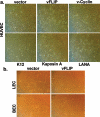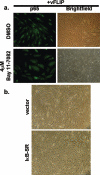Activation of NF-kappaB by the latent vFLIP gene of Kaposi's sarcoma-associated herpesvirus is required for the spindle shape of virus-infected endothelial cells and contributes to their proinflammatory phenotype
- PMID: 16809323
- PMCID: PMC1489050
- DOI: 10.1128/JVI.01603-05
Activation of NF-kappaB by the latent vFLIP gene of Kaposi's sarcoma-associated herpesvirus is required for the spindle shape of virus-infected endothelial cells and contributes to their proinflammatory phenotype
Abstract
Kaposi's sarcoma (KS) is an inflammatory angioproliferative lesion induced by the infection of endothelial cells with the KS-associated herpesvirus (KSHV). Infected endothelial cells assume an elongated (spindle) shape that is one of the histologic signatures of KS. In vitro, latent viral infection of primary endothelial cells (but no other cell type) strikingly recapitulates these morphological findings. Here we report that the spindling phenotype involves major rearrangement of the actin cytoskeleton and can be attributed to the expression of a single viral protein, vFLIP, a known activator of NF-kappaB. Consistent with this, the inhibition of NF-kappaB activation blocks vFLIP-induced spindling in cultured endothelial cells. vFLIP expression in spindle cells also induces the production of a variety of proinflammatory cytokines and cell surface adhesion proteins that likely contribute to the inflammatory component of KS lesions.
Figures




Similar articles
-
Gene regulation and functional alterations induced by Kaposi's sarcoma-associated herpesvirus-encoded ORFK13/vFLIP in endothelial cells.J Virol. 2009 Mar;83(5):2140-53. doi: 10.1128/JVI.01871-08. Epub 2008 Dec 17. J Virol. 2009. PMID: 19091861 Free PMC article.
-
A20/TNFAIP3 inhibits NF-κB activation induced by the Kaposi's sarcoma-associated herpesvirus vFLIP oncoprotein.Oncogene. 2013 Mar 7;32(10):1223-32. doi: 10.1038/onc.2012.145. Epub 2012 Apr 23. Oncogene. 2013. PMID: 22525270 Free PMC article.
-
Kaposi's sarcoma-associated herpesvirus encoded vFLIP induces cellular IL-6 expression: the role of the NF-kappaB and JNK/AP1 pathways.Oncogene. 2003 May 29;22(22):3371-85. doi: 10.1038/sj.onc.1206407. Oncogene. 2003. PMID: 12776188
-
Spindle cells and their role in Kaposi's sarcoma.Int J Biochem Cell Biol. 2005 Dec;37(12):2457-65. doi: 10.1016/j.biocel.2005.01.018. Epub 2005 Aug 1. Int J Biochem Cell Biol. 2005. PMID: 16188485 Review.
-
Manipulation of endothelial cells by KSHV: implications for angiogenesis and aberrant vascular differentiation.Semin Cancer Biol. 2014 Jun;26:69-77. doi: 10.1016/j.semcancer.2014.01.008. Epub 2014 Jan 28. Semin Cancer Biol. 2014. PMID: 24486643 Review.
Cited by
-
Kaposi's sarcoma herpesvirus K15 protein contributes to virus-induced angiogenesis by recruiting PLCγ1 and activating NFAT1-dependent RCAN1 expression.PLoS Pathog. 2012 Sep;8(9):e1002927. doi: 10.1371/journal.ppat.1002927. Epub 2012 Sep 27. PLoS Pathog. 2012. PMID: 23028325 Free PMC article.
-
Immune evasion in Kaposi's sarcoma-associated herpes virus associated oncogenesis.Semin Cancer Biol. 2008 Dec;18(6):423-36. doi: 10.1016/j.semcancer.2008.09.003. Epub 2008 Oct 2. Semin Cancer Biol. 2008. PMID: 18948197 Free PMC article. Review.
-
Interplay between Kaposi's sarcoma-associated herpesvirus and the innate immune system.Cytokine Growth Factor Rev. 2014 Oct;25(5):597-609. doi: 10.1016/j.cytogfr.2014.06.001. Epub 2014 Jun 21. Cytokine Growth Factor Rev. 2014. PMID: 25037686 Free PMC article. Review.
-
Viral Manipulation of a Mechanoresponsive Signaling Axis Disassembles Processing Bodies.Mol Cell Biol. 2021 Oct 26;41(11):e0039921. doi: 10.1128/MCB.00399-21. Epub 2021 Sep 13. Mol Cell Biol. 2021. PMID: 34516278 Free PMC article.
-
NF-kappaB serves as a cellular sensor of Kaposi's sarcoma-associated herpesvirus latency and negatively regulates K-Rta by antagonizing the RBP-Jkappa coactivator.J Virol. 2009 May;83(9):4435-46. doi: 10.1128/JVI.01999-08. Epub 2009 Feb 25. J Virol. 2009. PMID: 19244329 Free PMC article.
References
-
- An, J., Y. Sun, R. Sun, and M. B. Rettig. 2003. Kaposi's sarcoma-associated herpesvirus encoded vFLIP induces cellular IL-6 expression: the role of the NF-κB and JNK/AP1 pathways. Oncogene 22:3371-3385. - PubMed
-
- Belanger, C., A. Gravel, A. Tomoiu, M. E. Janelle, J. Gosselin, M. J. Tremblay, and L. Flamand. 2001. Human herpesvirus 8 viral FLICE-inhibitory protein inhibits Fas-mediated apoptosis through binding and prevention of procaspase-8 maturation. J. Hum. Virol. 4:62-73. - PubMed
-
- Bhullar, I. S., Y. S. Li, H. Miao, E. Zandi, M. Kim, J. Y. Shyy, and S. Chien. 1998. Fluid shear stress activation of IκB kinase is integrin-dependent. J. Biol. Chem. 273:30544-30549. - PubMed
-
- Boshoff, C., T. F. Schulz, M. M. Kennedy, A. K. Graham, C. Fisher, A. Thomas, J. O. McGee, R. A. Weiss, and J. J. O'Leary. 1995. Kaposi's sarcoma-associated herpesvirus infects endothelial and spindle cells. Nat. Med. 1:1274-1278. - PubMed
MeSH terms
Substances
LinkOut - more resources
Full Text Sources
Medical

